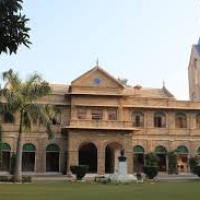Scindia Kanya Vidyalaya in Gwalior, Madhya Pradesh Admission, Fees Structure

Where is Scindia Kanya Vidyalaya ?
Scindia Kanya Vidyalaya is Located in Gwalior , Madhya Pradesh, India
Address of Scindia Kanya Vidyalaya, Gwalior
Gwalior - 474007
Madhya Pradesh
INDIA
+91-7512322137
+91-7828102626
info@skvgwalior.org
How do I contact Scindia Kanya Vidyalaya?
Call at +91-7512322137 to contact Scindia Kanya Vidyalaya
About Scindia Kanya Vidyalaya
Scindia Kanya Vidyalaya is an all-girls' residential school - located in Gwalior- a historical city of Madhya Pradesh. About 300 Km south of Delhi, it is well connected with all major cities of the country. The school was founded by Late Rajmata of Gwalior Srimant Vijaya Raje Scindia in 1956 with a view to educating the girl child in the context of newly independent India. It embodies her dream of providing progressive modern education and equipping young girls to be good citizens. Inaugurated by the then President of India, H E Dr Rajendra Prasad, the school took off on its mission to stay grounded to roots of tradition and to take wing in the exhilarating air of freedom. The entry level class at SKV is standard VI. In today's competitive world, the need of the hour is to reduce the stress level of the students and at the same time increase their creativity. The school tries to develop in our students the ability to 'create' as against 'copy' by providing an experiential learning curriculum in the formative years. It not only enhances their learning potentials but also brings them to the center stage of learning. It facilitates the students taking charge of their own learning as well as making the content relevant to them. The school is affiliated to Central Board of Secondary Education New Delhi. The medium of instruction is English. The subjects taught at +2 level include English, Hindi, Sanskrit, History, Geography, Sociology, Political Science, Painting, Music -Vocal as well as Instrumental, Dance- Kathak and Manipuri style, Psychology, Physical Education, Physics, Chemistry, Mathematics, Biology, Bio-Tech, Home Science, C++, Web Page Media, Business Studies, Accountancy, Economics and Entrepreneurship. The school follows a system of CCE - Continuous Comprehensive Evaluation for classes VI - X where student's performance is assessed throughout the academic session on the basis of Formative and Summative assessments.
Besides being the administrative headquarters of Gwalior district and Gwalior division, Gwalior has many administrative offices of the Chambal division of northern Madhya Pradesh Several administrative and judicial organisations, commissions and boards have their state and national headquarters situated in the city Gwalior was the winter capital of the state of Madhya Bharat which later became a part of the larger state of Madhya Pradesh Prior to Indian independence on 15 August 1947, Gwalior remained a princely state of the British Raj with the Scindia as the local rulers High rocky hills surround the city from all sides, on the north it just forms the border of the Ganga- Yamuna Drainage Basin.
The city however is situated in the valley between the hills Gwalior's metropolitan area includes Gwalior city centre, Morar Cantonment, Lashkar Gwalior (Lashkar Subcity), Maharaj Bada, Phool Bagh, ThatipurGwalior was one of the major sites of rebellion during the 1857 uprising Post-independence, Gwalior has emerged as an important tourist attraction in central India while many industries and administrative offices came up within the city Before the end of the 20th century it became a million plus agglomeration and now it is a metropolitan city in central India.
Gwalior is surrounded by industrial and commercial zones of neighbouring districts (Malanpur – Bhind, Banmore – Morena) on all three main directions A 2016 report of the World Health Organization found Gwalior to be the second-most air-polluted city in the world and the most polluted city in IndiaGwalior has been selected as one of the hundred Indian cities to be developed as a smart city under PM Narendra Modi's flagship Smart Cities Mission
Subsequently, the region was ruled by the major dynasties of India The Maratha empire dominated the majority of the 18th century After the Anglo Maratha Wars 19th century, the region was divided into several princely states under the British and incorporated into Central Provinces and Berar and the Central India Agency After India's independence, Madhya Pradesh state was created with Nagpur as its capital: this state included the southern parts of the present-day Madhya Pradesh and northeastern portion of today's Maharashtra In 1956, this state was reorganised and its parts were combined with the states of Madhya Bharat, Vindhya Pradesh and Bhopal to form the new Madhya Pradesh state, the Marathi-speaking Vidarbha region was removed and merged with the Bombay State.
This state was the largest in India by area until 2000, when its southeastern Chhattisgarh region was designated a separate state The economy of Madhya Pradesh is the tenth-largest state economy in India with ₹809 lakh crore (US$110 billion) in gross domestic product and a per capita GDP of ₹90,000 (US$1,300) Madhya Pradesh ranks 32nd among Indian states in human development index Rich in mineral resources, Madhya Pradesh has the largest reserves of diamond and copper in India.
More than 30% of its area is under forest cover Its tourism industry has seen considerable growth, with the state topping the National Tourism Awards in 2010–11 In recent years, the state's GDP growth has been above the national average